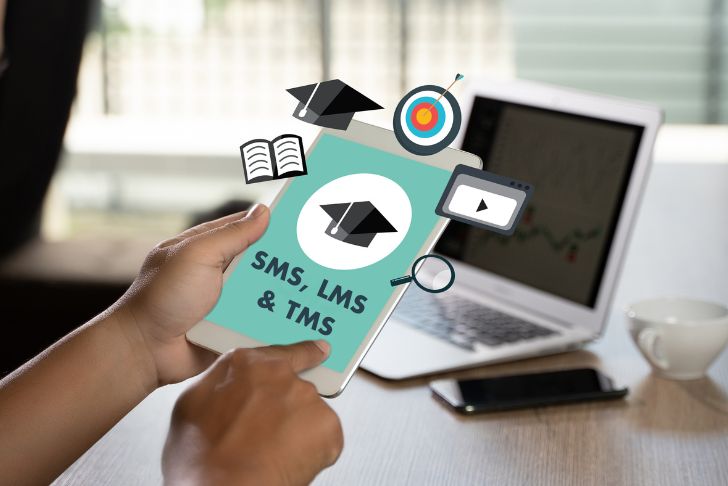Have you ever found yourself scratching your head over the acronyms SMS, LMS, and TMS? You’re not alone. These systems, crucial to the functioning of educational and training organizations, often come up in discussions about learning technology, yet many find it difficult to distinguish between them clearly. Let’s clear up the confusion by breaking down the roles and advantages of each system.
Understanding the Basics
What is an SMS (Student Management System)?
An SMS, or Student Management System, is primarily used by educational institutions to manage student-related data. This system acts as a digital ledger of all student interactions from the point of inquiry through to graduation.
Key Features of SMS:
- Enrollment Management: Streamline the process from application to admission.
- Grade Tracking: Automatically record and update student grades.
- Attendance Management: Keep an accurate log of student attendance.
- Compliance Reporting: Generate reports that comply with educational standards.
SMS simplifies the administrative workload, enhances communication between staff and students, and ensures that an institution stays compliant with education laws and policies.
What is an LMS (Learning Management System)?
A Learning Management System or LMS, on the other hand, is a platform that facilitates the online aspect of learning. It’s the go-to system for handling the delivery of educational courses and training programs.
Key Features of LMS:
- Content Delivery: Hosts and streams course content including videos, slides, and documents.
- Assessment Tools: Facilitate testing and quizzes to assess student learning.
- Discussion Forums: Provide spaces for students to discuss course materials and collaborate.
- Tracking Learning Progress: Monitor student progress and identify areas needing attention.
The LMS focuses on the ‘learning’ component, providing tools that support both the creation and delivery of educational content, while also offering analytics on student engagement.
What is a TMS (Training Management System)?
A Training Management System or TMS is often used by organizations to manage enterprise-level training programs. It is particularly useful for handling logistics of training including scheduling, tracking, and reporting.
Key Features of TMS:
- Resource Allocation: Manage instructors, venues, and equipment through the system.
- Client Management: Track which clients have attended what training and their feedback.
- Billing and Invoicing: Integrate financial aspects directly with the training specifics.
- Certification Management: Issue and manage certificates for completed trainings.
TMS is designed to streamline the back-end operations of running training programs, making it invaluable for organizations that provide professional development and certification.
Deep Dive into System Capabilities
Comparison of Features
Let’s lay out a clear comparison to see how these three systems overlap and differ in terms of functionality.
| Feature | SMS | LMS | TMS |
|---|---|---|---|
| Enrollment Management | Yes | Often | Yes |
| Grade Tracking | Yes | Yes | No |
| Content Delivery | No | Yes | No |
| Certification | Yes (academic awards) | Yes (course-specific) | Yes (professional) |
| Reporting Compliance | Essential | Optional | Often Essential |
| Billing & Invoicing | No | No | Yes |
Choosing the Right System for Your Needs
When you’re choosing between an SMS, LMS, and TMS, consider what your core needs are:
- Educational Institutions: Likely need an SMS to handle the vast amounts of student data and compliance requirements.
- Corporate Training Needs: Might opt for a TMS if the focus is on scheduling, managing, and tracking corporate training sessions.
- E-learning Focus: An LMS would be your best bet for delivering courses and tracking educational outcomes online.
Real-World Application and Benefits
SMS in Action
Imagine a university that handles thousands of students and multiple programs. An SMS can manage everything from admissions to alumni details, making it an indispensable tool for large educational organizations.
LMS at Work
Consider a global corporation implementing mandatory training for its employees across different regions. An LMS allows for the uniform distribution of training materials, making sure everyone is on the same page, regardless of location.
TMS for Organizational Training
Think of a company that needs to ensure all its employees are certified in a new software tool. A TMS can schedule the training sessions, manage the registrants, deliver necessary learning materials, and issue certifications upon completion.
Future of SMS, LMS, and TMS Technologies
Trends to Watch
As technology advances, so too do the capabilities of SMS, LMS, and TMS platforms. Expect to see more integration with AI for personalized learning experiences, enhanced data analytics for deeper insights, and increased use of VR and AR for training simulations.
Continuous Evolution
The field of learning and training management is always evolving. Staying informed about these systems ensures that you can make the best choices for your organization, keeping you a step ahead in managing educational and training processes efficiently.
By understanding the specific functionalities and benefits of an SMS, LMS, and TMS, you can choose a system that not only meets your immediate needs but also supports your long-term goals. Here’s to making an informed decision that propels your educational or training organization forward!




